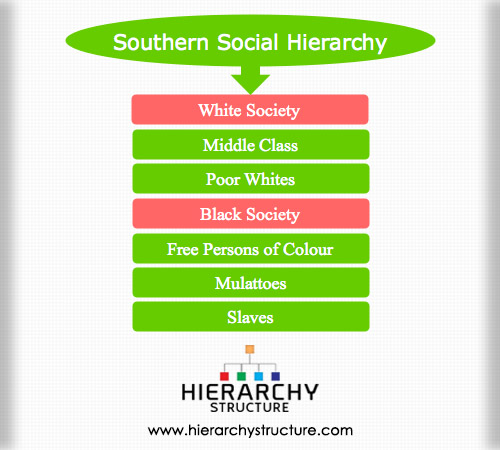A Southern Society was a bi-racial society, which was further divided into sub-classes within the races. The Southern Society was divided into the White Society and the Black Society. A White Society was further divided into the Planters, Middle Class and the Poor Whites. A Black Society was divided into the free persons of Colours, Mulattoes and the Slaves. The social hierarchical structure of the Southern state of South Africa is mentioned below.
1. White Society
Planters: The Planters were less in number, but were the rich class and had most of Southern States wealth. Planters managed large enterprises and were absentee owners, who left a manager in charge of the plantation. Overall, out of a population of 8 million, only 383,637 owned slaves and there were few individuals in 1860 who qualified as planters, owning more than twenty slaves.
Middle Class
Most of the Southerners belonged to the Middle Class strata and were known as yeoman farmers, who had few acres of land and led a modest life in homes, raising chickens, and growing cotton and corn. Only few of these yeoman farmers had slaves that too only one or two. These farmers traded eggs and milk for required services like blacksmithing and shoemaking. Though only few of the middle class people had slaves but all supported the racial slave system as they enjoyed the privileges bestowed on them and feared that they might have to compete with slaves for work and land if the African Americans were freed someday.
Poor Whites
The Poor Whites struggled for survival and were always in debt to the planters of the South. They constantly moved from place to place in search for better living. Due to poverty, they suffered from diseases like malaria, hookworm, and pellagra. They did not possess slaves and depended on the hard work provided by their families and themselves to meet their ends.
2. Black Society
Free Persons of Colour
This class was between freedom and slavery and they were distinguished based on their skin colour. These people were freed as indentured servants or they bought their freedom with the money they saved. Some of them were freed during the war of American Revolution.
Mulattoes
They were people of mixed breed and, coloured and owned large plantations especially in New Orleans, where their own slaves worked. Mulattoes had limited rights and were suspected by the whites that they might be the cause of slavery rebellion. They always had to carry passes and documents to prove their free status. In case they lost these documents, they could become bonded labourers again.
Slaves
Slaves comprised the bottom rung of the social hierarchy. The lives of the slaves were miserable and most of the slaves resided in slave quarters, away from main house of their masters, in homes they built. Their masters gave clothes and shoes twice a year for use during the winter months. They toiled from morning to dusk and the average price of slaves was $ 1,500-$2,000 before the war. Most slaves worked on plantations and some became skilled craftsmen.
Slave rebellion was a constant threat in the Southern States; as a result the whites formulated laws to ward off the possibility of slave uprising like the prohibition of slave education and the carrying of permit for the slaves and so on.

